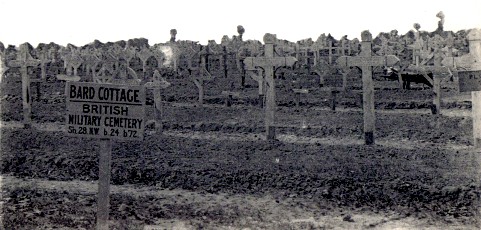George William Caines
Date of birth: 1898
Date of death: 20.9.1917
Area: Lofthouse Gate
Regiment: King's Own Yorkshire Light Infantry
Family information: Son of William and Georgina Caines
Rank: Private
Service number: 205350
War Service
During August 1917, after receiving some training in the United Kingdom, Private George William Caines was drafted to the 7th Battalion, in Flanders.
The 7th KOYLI had joined the British Expeditionary Force in 1915 and had seen action within the Ypres Salient and on the Somme. On 21st July 1917, the 7th KOYLI, part of 61st Brigade, 20th (Light) Division, had moved north from the Somme region to Proven. Here they were to prepare for an assault, during the next phase of the third Battle of Ypres, known as Passchendaele. A short tour in the line followed, when the battalion experienced mustard gas for the first time.
On 15th August, the 7th KOYLI, in Brigade, was in assembly positions on the forward slopes of Pilkem Ridge. At 03.30 hrs. on the 16th August, under an intense barrage, 7th KOYLI advanced towards the village of Langemarck. The ground in front was covered in water-filled shell holes and it was difficult to keep pace with the creeping barrage, as men became stuck in the mud. By the time they were 100 yards from their first objective, almost half the battalion were casualties from machine-gun fire. With the first objective taken, the battalion found the ground to the second objective was a sea of mud. With the direct line impassable, the battalion progressed around the swamp and reached their second objective and dug in. There was enemy shelling for the rest of the day, but the battalion remained in these positions until relieved during the night of 17th August. The 7th KOYLI sustained over 200 casualties during the attack.
Private George William Caines probably joined the 7th Battalion on 2nd September 1917, at Palma Camp, Proven, along with a draft of 96 other ranks. On 12th September the battalion returned to the front line, for a short tour at Langemarck. Here they came under intermittent shell fire before moving back to the Reserve Area, near the Yser Canal. Here, on 15th September, the battalion incurred casualties from enemy shelling and machine gun fire from aeroplanes, before moving back to the front line, at Langemarck.
George William Caines died from his wounds on 20th September 1917, about six weeks after arriving in France. He was buried in the Bards Cottage Cemetery at Boesinghe, a village in Belgium, directly facing the German lines across the Yser Canal. Bard Cottage was a house, set back from the front line, close to a bridge called the Bards Causeway. The cemetery is nearby, in a sheltered position under a high bank and now contains a total of 1639 Commonwealth burials, 39 of them are unidentified.
Family Life
George William Caines was born on 19th August 1898, the son of William and Georgina Caines of Lingwell Nook, Outwood. Some weeks later, on 30th October, he was baptised at St Mary Magdalene Church, Outwood. His father and two brothers were mine workers and, on leaving school, George William followed in their footsteps. George William Caines was employed at Lofthouse Colliery, but on 25th May 1917, he enlisted in the Kings Own Yorkshire Light Infantry. At this time, his parents were living at Holroyd Buildings, Potovens Lane, Lofthouse Gate.
 Bard Cottage British Military Cemetery
Bard Cottage British Military Cemetery

